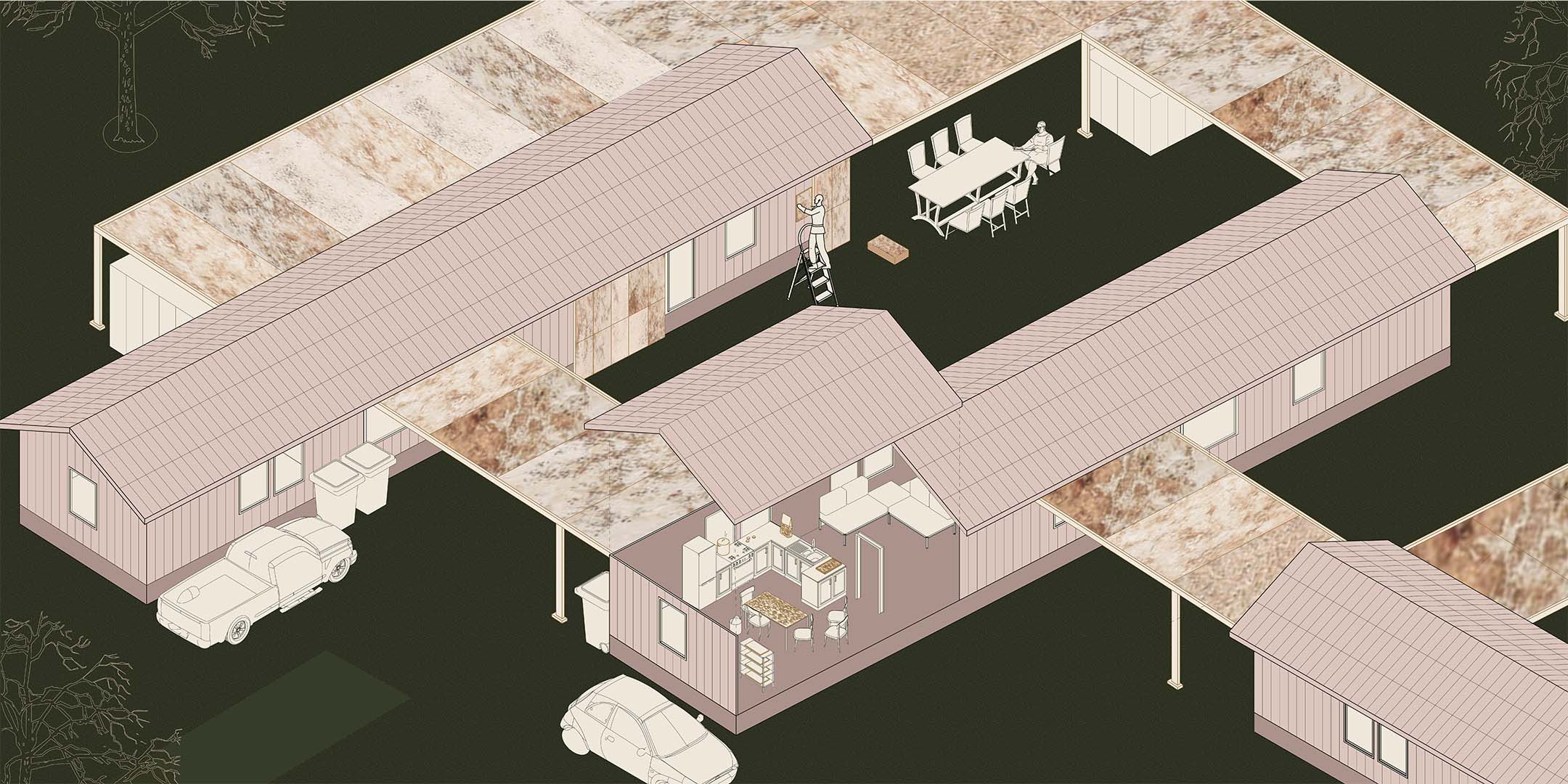





Mycelium as Connective Building Tissue
Mycelium is a network of fungal roots that can function as non-formaldehyde adhesive glue in binding organic wastes into constructing materials such as particle boards. Through introducing mycelium panels as connective building tissue, we design a carbon neutral, circular manufacturing and building system.Instead of a linear process going from extraction to production, consumption, and waste, we propose a circular system where agricultural waste distribution, mycelium cultivation, structure construction, and material decay can all take place within the selected site.
Connectivity, the thesis of our design proposal, takes place on three levels: first, on the territorial level, informed by the life cycle of mycelium material,we introduce an urban strategy that connects the river valley context of El Paso-Ciudad Juárez with agricultural waste sourcing, lab manufacturing, mobile housing improvement and waste reuse. Second, on the urban level, we design a manufacturing and exhibiting site that mass produces standardized mycelium panels and connects with the surrounding neighborhoods through mycelium experimental structures, an urban garden, and a farmers’ market. Third, on the architectural level, we use mycelium panels to infiltrate mobile housing neighborhoods, providing insulation and new circulation that connects isolated housings into communal spaces.
Left images: (1) Stage I: substrates are transported into the storage and prepared for mass production of mycelium panels. (2) Stage II: an experimental structure is built to exhibit the architectural qualities of mycelium panels. In the third stage, an urban garden is built with mycelium panels, using the design strategy that we showed in the concept collage. (3) Stage III: mycelium panels start to infiltrate mobile housing neighborhoods. Standardized panels start to create conditions such as courtyards, backyards, alleyways for different activities such as barbecues and collective cooking, shading parking shelters, and acoustic walls to block traffic noise. At the same time, build-at-home kits, which include packaged substrates, moulds, and a self-built instruction manual, will enable individuals to cultivate and produce mycelium panels to replace degraded ones, using their own kitchen space.
Fall 2021, collab with Tony Dai.
Mycelium is a network of fungal roots that can function as non-formaldehyde adhesive glue in binding organic wastes into constructing materials such as particle boards. Through introducing mycelium panels as connective building tissue, we design a carbon neutral, circular manufacturing and building system.Instead of a linear process going from extraction to production, consumption, and waste, we propose a circular system where agricultural waste distribution, mycelium cultivation, structure construction, and material decay can all take place within the selected site.
Connectivity, the thesis of our design proposal, takes place on three levels: first, on the territorial level, informed by the life cycle of mycelium material,we introduce an urban strategy that connects the river valley context of El Paso-Ciudad Juárez with agricultural waste sourcing, lab manufacturing, mobile housing improvement and waste reuse. Second, on the urban level, we design a manufacturing and exhibiting site that mass produces standardized mycelium panels and connects with the surrounding neighborhoods through mycelium experimental structures, an urban garden, and a farmers’ market. Third, on the architectural level, we use mycelium panels to infiltrate mobile housing neighborhoods, providing insulation and new circulation that connects isolated housings into communal spaces.
Left images: (1) Stage I: substrates are transported into the storage and prepared for mass production of mycelium panels. (2) Stage II: an experimental structure is built to exhibit the architectural qualities of mycelium panels. In the third stage, an urban garden is built with mycelium panels, using the design strategy that we showed in the concept collage. (3) Stage III: mycelium panels start to infiltrate mobile housing neighborhoods. Standardized panels start to create conditions such as courtyards, backyards, alleyways for different activities such as barbecues and collective cooking, shading parking shelters, and acoustic walls to block traffic noise. At the same time, build-at-home kits, which include packaged substrates, moulds, and a self-built instruction manual, will enable individuals to cultivate and produce mycelium panels to replace degraded ones, using their own kitchen space.
Fall 2021, collab with Tony Dai.